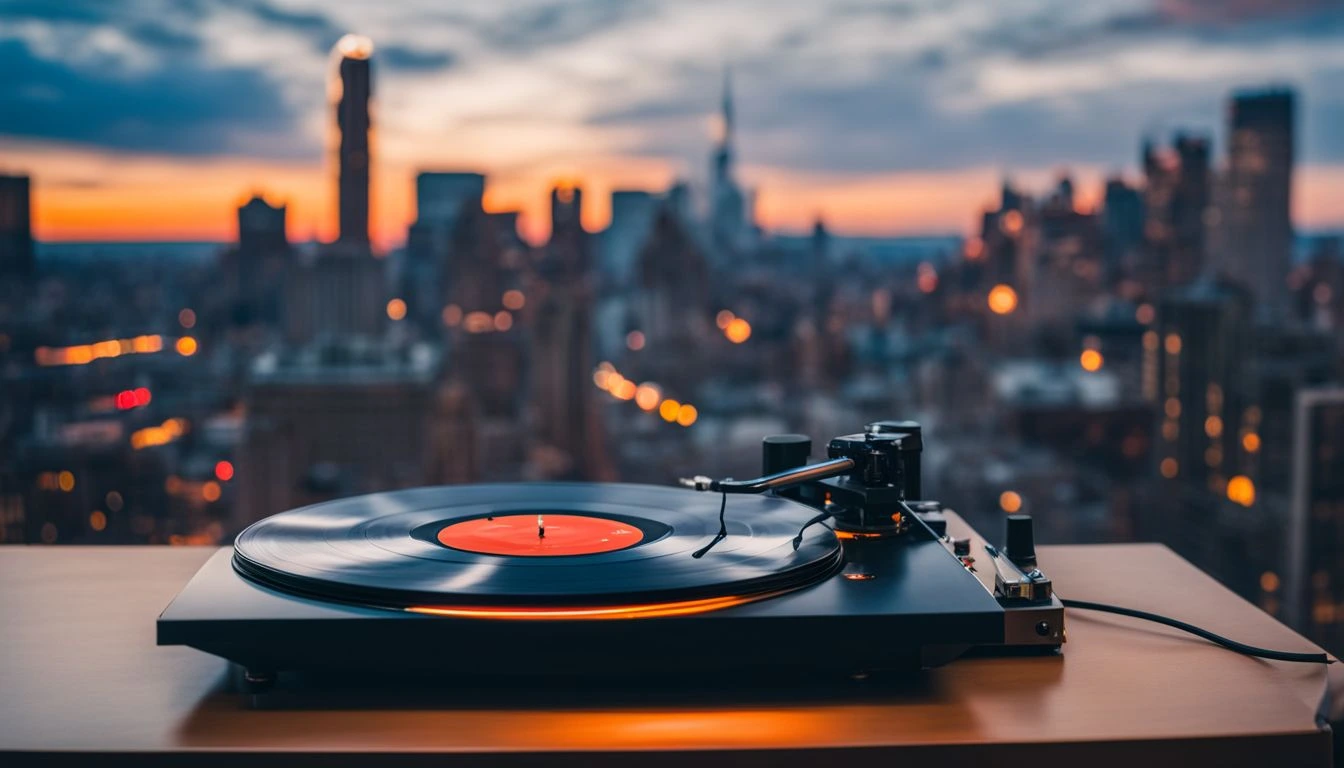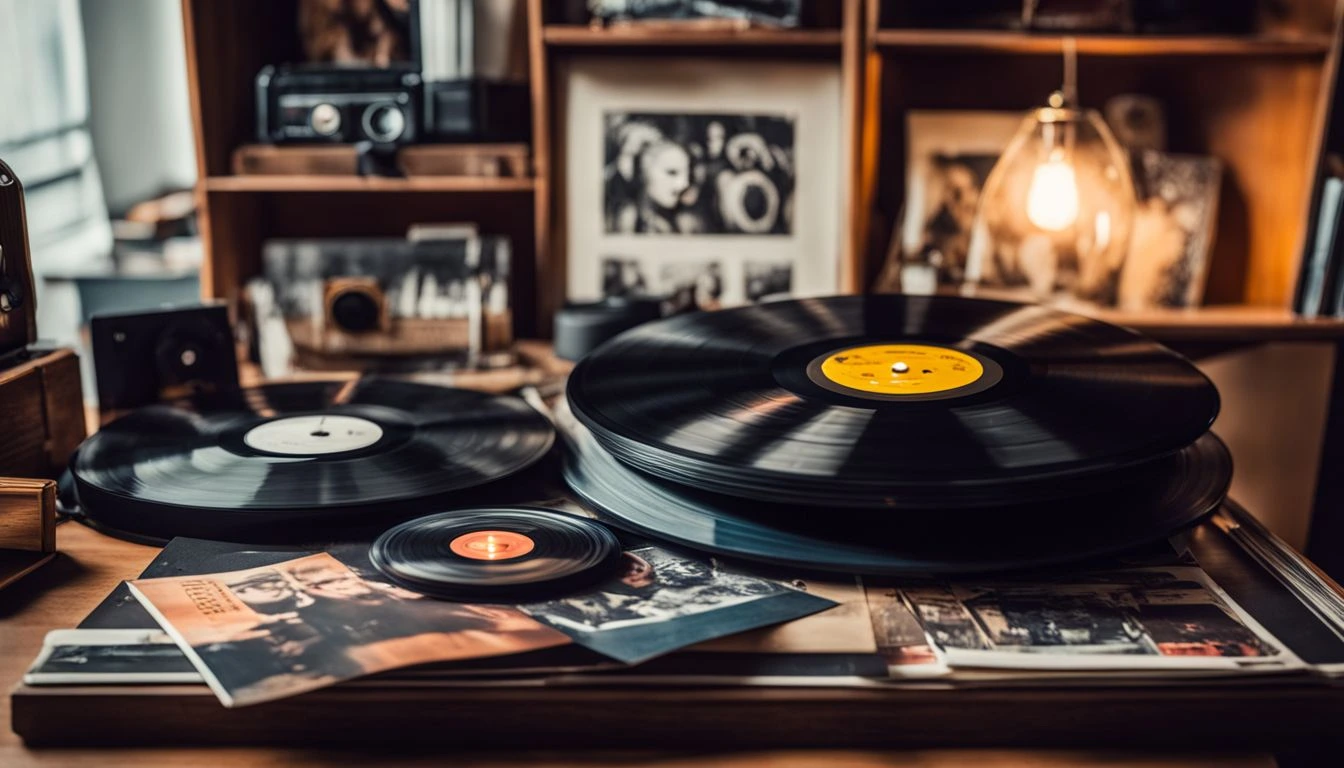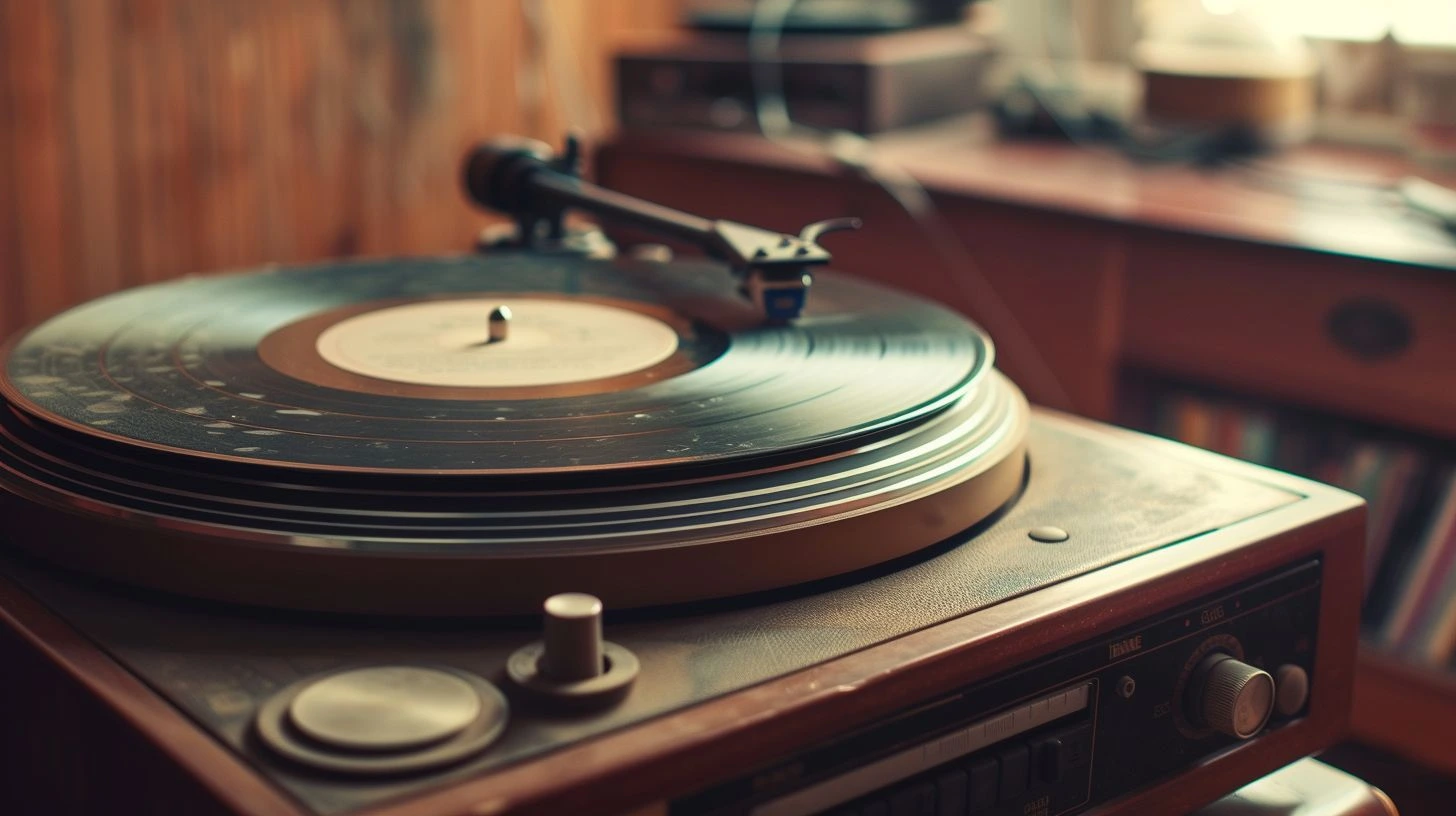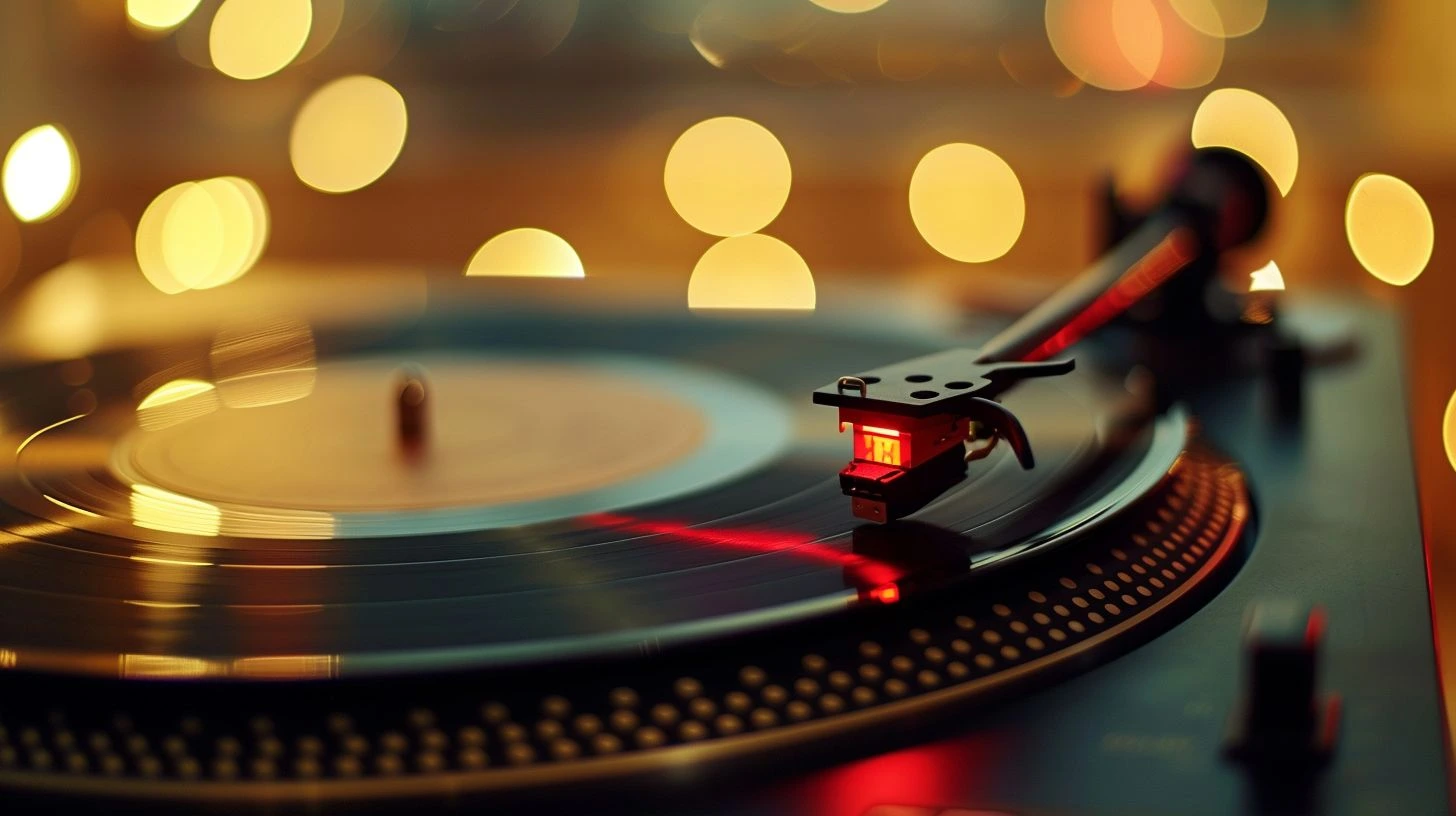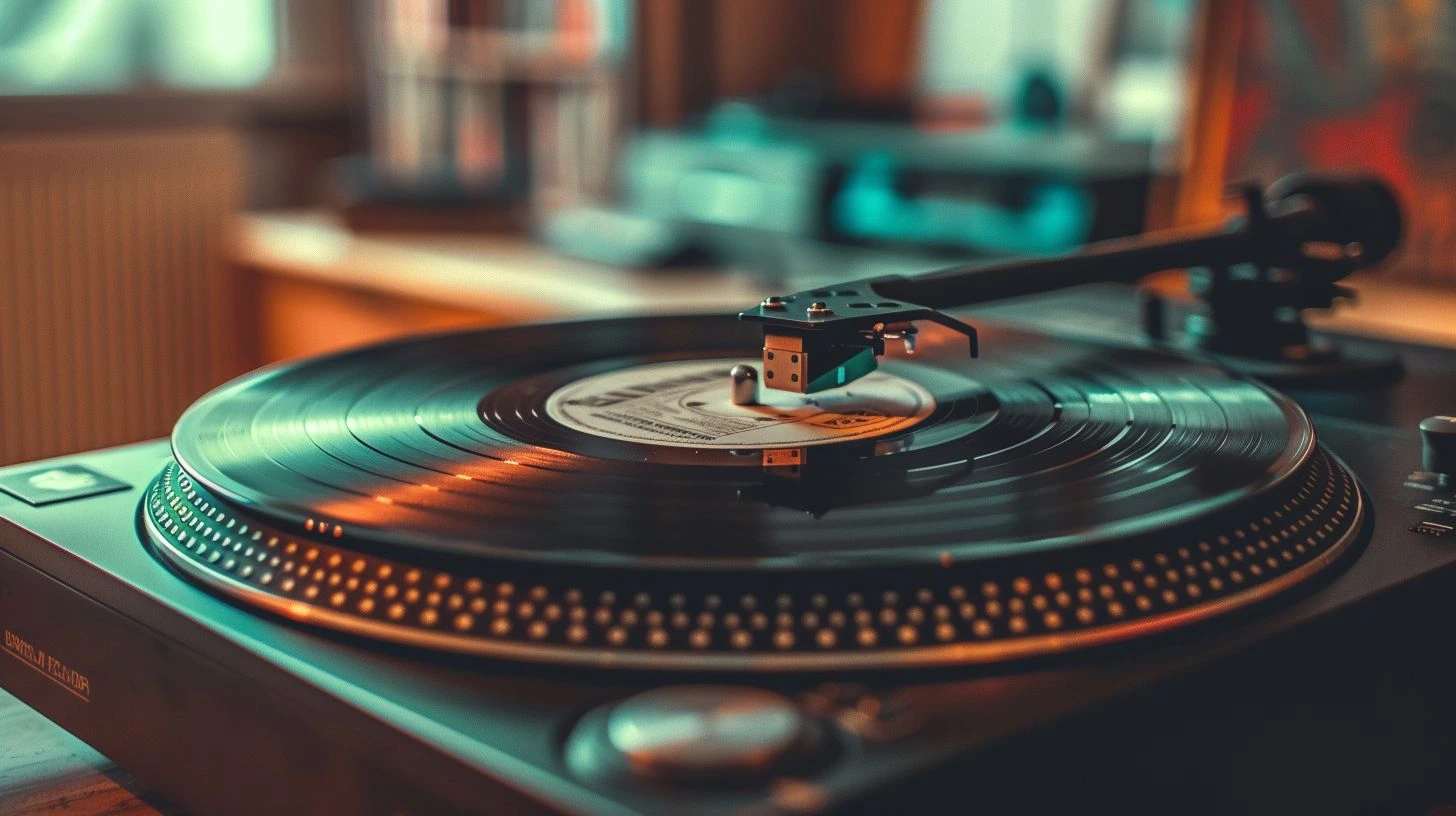Selecting the perfect album cover size for your vinyl record can be puzzling, especially if you’re new to vinyl collecting. Did you know the typical LP sleeve measures a square of 12.375 inches? This blog post will unpack the dimensions and design tips that ensure your vinyl record covers look professional and captivating.
Get ready to make your music stand out!
Key Takeaways
- The standard size for a 12-inch vinyl record cover is between 12.25 and 12.375 inches square, offering lots of space for creative design.
- For smaller records, 10-inch covers measure about 10.227 inches square, while the typical size for a 7-inch cover is slightly over 7 inches by 7 inches.
- Album artwork must be high-quality imagery to avoid blurriness when printed; the ideal resolution is around 3000 pixels by 3000 pixels at a crisp 300 dots per inch (DPI).
- Vinyl covers can be customized with different paper types and special finishes like embossing or foil to stand out on shelves.
- In the digital world, album covers also serve as crucial visual icons on streaming platforms, where they are often displayed in square layouts at specific dimensions recommended by each service.
Understanding the Importance of Vinyl Cover Design
Beyond mere protection for the grooves beneath, the vinyl record cover stands as a canvas for creativity—a critical meeting point between art and music where first impressions are made.
It’s here that listeners encounter an artist’s visual statement, one that often becomes as iconic as the sounds it encases.
Role of album artwork
Album artwork grabs your attention and can make you want to pick up a record. Alex Steinweiss, the first art director at Columbia Records, started this trend back in 1938. His creative designs turned plain record covers into pieces of art.
These artworks tell a story even before you play the first song. They set the mood and give clues about what’s inside.
Think about iconic images like “The Dark Side of the Moon” or “Sgt. Pepper’s Lonely Hearts Club Band.” They stick with us just as much as the music does. Album art is more than decoration; it’s part of the whole experience that artists share with their fans.
It also helps create a brand for musicians that fans can recognize anywhere, from vinyl records to digital album thumbnails on Spotify or Apple Music.
Essential elements of cover art
Cover art is your album’s first hello to the world—it tells a story before a song even plays. Good artwork includes the artist’s name, album title, and sometimes branding and track listing.
It sets the mood with photos or designs that match your music style. Think of it as a quick peek into what you’re all about.
Your genre really matters here; rock might go for something edgy, while pop could be bright and in-your-face. And then there are those little extras, like embossing or shiny foil, that can make people take notice.
Imagine someone flipping through records—they’ll stop at the ones whose covers pop out at them. Next up, let’s talk dimensions—how big is this canvas you have to work with?.
Standard Dimensions of a Vinyl Record Cover
Delving into the world of vinyl brings us to an essential aspect that is often taken for granted—the album covers that not only protect but also express the essence of the music within.
Let’s unpack the standard dimensions that serve as a canvas for graphic design ingenuity and marketing flair, ensuring your record visually stands out as much as it audibly resonates.
Dimensions of a 12-inch record cover
A 12-inch record cover usually measures between 12.25 and 12.375 inches square. This standard size gives enough space for artists to create striking album cover art that catches the eye.
The artwork on these covers can play a big role in how we connect with the music inside.
Designers work hard to make sure every inch of a vinyl album cover stands out on shelves or online listings. They consider everything, from color choices to typography, knowing that the right design can become iconic.
Fans often display their favorite LPs like works of art, thanks to these carefully crafted covers.
Dimensions of a 10-inch record cover
Shifting focus to the slightly smaller 10-inch vinyl, its cover holds a unique place in record storage. Each side of this square protector measures precisely 10.227 inches, providing a snug fit for the disc inside.
This size is perfect for albums originally released in the classic 78 rpm format or modern EPs that don’t need as much space as a full LP.
Designing for this dimension gives artists and creators an intermediate canvas between the larger 12-inch and the compact 7-inch covers. It allows enough room to make a bold statement while maintaining an intimate feel that fans appreciate when flipping through their collection.
The themes and images chosen for these covers play a crucial role in connecting listeners with the music before they even place it on their turntables.
Dimensions of a 7-inch record cover
A 7-inch record cover is smaller than the others. It needs to fit the vinyl snugly. The standard size for these covers is just over 7 inches by 7 inches, giving you enough room to protect your music disc while keeping it compact and easy to handle.
Artists often get creative within this limited space, making designs that stand out on shelves.
For a perfect fit around a single or EP, these dimensions are key. You must check that your artwork aligns well with this size before printing. Sharp images and bold colors can make even a small cover pop in someone’s collection.
Remember, good design doesn’t need lots of space; it just needs smart use of what you have!
Key Considerations for Vinyl Cover Design
Creating a vinyl cover is an art form, demanding attention to detail and design principles that ensure your musical masterpiece looks as good as it sounds. In the realm of vinyl cover design, understanding size specifications and aesthetic nuances can make all the difference between an iconic album cover and a visual misfire.
Selecting the right size for the art
Choosing the correct size for your vinyl record cover art is key. It needs to match the format of your record. For a standard 12-inch LP, aim for artwork that’s square and large enough to look great when printed.
Think big, clear images with no blur—3000 pixels by 3000 pixels at a crisp 300 dots per inch (DPI) will do the trick.
Make sure your design fits well within these dimensions. You don’t want important details to get cut off or wrapped awkwardly around edges. Check that everything from text to pictures stays inside the safe area, which is slightly smaller than the full size of the cover.
This helps keep your design looking sharp after it’s printed and folded into its sleeve.
Checking the design before submission
Getting your vinyl cover design right is key. Before you send it off, make sure everything looks perfect. Here’s how to check your design:
- Print a test copy of the final design using the template from RPM Records or the pressing plant.
- Compare the printed sample to digital mock-ups to catch any color discrepancies.
- Make sure all the text on the cover is easy to read and free from errors.
- Look over the artwork for unwanted pixelation or blurring, a sign of low image resolution.
- Confirm that the dimensions match those required for 12-inch, 10-inch, or 7-inch records.
- Check that no important parts of the design are close to the edges, where they might get cut off.
- Verify if additional elements, like parental advisory labels, are placed correctly and clearly visible.
- Make sure that all of the graphics and images you use have the proper licenses or are your own.
- Confirm that the liner notes and track listings on the inner sleeve contain accurate information about the music.
Common design mistakes to avoid
Creating a vinyl record cover is like making art for music. You must get it right to catch the eye and respect the album’s spirit. Here’s what you should steer clear of:
- Ignoring bleed areas and safe zones. Always leave extra space around the edges so important parts don’t get cut off.
- Using low-resolution images can lead to blurry or pixelated covers. Aim for high pixel density in your artwork.
- Forgetting about the back cover details. Remember, the back is just as important as the front cover for track lists and credits.
- Overlooking the spine design might make your record hard to spot on a shelf. Make sure the spine is readable and stands out.
- Missing out on proofreading can cause typos and errors in your text. Check everything twice before finalizing the design.
- Choosing clashing colors might turn fans away. Pick a color scheme that complements your album’s mood.
- Not planning for vinyl size differences between 12″, 10″, and 7″ records means your design may not fit properly on each format.
The Impact of Different Vinyl Record Sizes on Cover Design
The dimensions of a vinyl record—whether it’s the expansive canvas of a 12-inch, the mid-range 10-inch, or the compact 7-inch—affect not just visual impact but also functional design considerations; uncover how these variations influence creativity and practicality in album cover artistry.
12 Inch Vinyl Record Covers
12-inch vinyl record covers are like a blank canvas for artists. They measure 12.375 inches square, offering plenty of space for eye-catching art and important information about the music inside.
These large covers became famous thanks to classic albums by the Beatles and Rolling Stones. Fans love them not just for protecting their records but also because they’re beautiful pieces to collect and display.
Designers have room to play with bold images and text on these big sleeves. Some choose to add gatefold covers that open up, revealing even more artwork or lyrics inside. This extra space lets bands share their story in pictures as well as songs.
Album art on 12-inch vinyl can be so striking that it sticks in your memory long after the music stops playing.
10 inch vinyl record covers
10-inch vinyl record covers hold a unique place in music packaging. They measure exactly 10.227 inches square, giving them a distinctive look that stands out from the common 12-inch album artwork.
These smaller sleeves can pack a visual punch, offering enough space for creative designs without overwhelming the canvas.
Artists often choose this size to create collectible items or special editions of their studio albums. With RPM Records, you have flexible options: go with blank center labels, no labels at all, or fully printed ones to complement your cover art.
This customization lets musicians and designers personalize every aspect of their vinyl releases for fans and collectors alike.
7-Inch Vinyl Record Covers
7-inch vinyl record covers are small and simple. They need less information than larger albums. Artists often use these covers to make a bold statement with just a few words or an eye-catching image.
The artist’s name and album title may appear on the front, but some choose a unique approach.
These covers can be made from different materials, such as 135 gsm paper or 280 gsm board. Designers also use plastic sleeves that show off the center label artwork. For singles with shorter playback, creators recommend vinyl etching on one side—this adds flair while keeping it practical.
The next topic will explore “The Role of Album Cover in Digital Platforms.”
The Role of Album Covers on Digital Platforms
In the digital age, album covers face a new frontier; they’re not just packaging but also key visual icons in online stores and streaming services. The transition to pixels from print means cover art must adapt to various screen sizes and formats without losing its impact—every thumbnail counts in catching a listener’s eye amongst the sea of digital albums.
Size of album covers on streaming platforms
Streaming services like iTunes have specific needs for album cover sizes. They recommend covers to be 3000 pixels by 3000 pixels at a high resolution of 300 DPI. This size makes sure the artwork looks sharp on any device, from phones to big screens.
Keep in mind that using the right dimensions is crucial for your music to stand out and look professional online.
Most streaming platforms use a square layout for album art. Be sure you save your image files as JPEG or PNG formats with an sRGB color space for the best results. This keeps colors vibrant across all digital platforms where fans might stream or download your music.
Your cover art is often the first thing people see, so make it count!
Additional Aspects of Vinyl Cover Design
Delving into the creative realm of vinyl cover design unveils a spectrum of paper finishes and vibrant color palettes, paving the way for personalization that resonates with artists and audiences alike—discover how these elements can elevate your record’s visual narrative.
Paper options and color choices
Paper choices for vinyl covers come in many types. You might pick glossy, matte, or even textured paper to make your album stand out. Think about how the feel of the paper can match your music’s vibe.
Color plays a huge part too. Go bold with full-color designs or keep it classic with black-and-white imagery. Remember that metallic and daylight colors need special attention; they can’t be overprinted.
Adding special touches like a UV finish or silver foil can take your cover from good to great. These finishes bring life to your artwork and catch eyes on the shelf. Just make sure you check how colors look on different papers before you decide.
Your album cover tells a story before anyone hears the first note, so choose wisely!
Customization possibilities
Vinyl covers offer endless ways to shine. Artists can choose special finishes, like embossing or silver foil, to grab attention. Even the vinyl itself can be a canvas, with swirl patterns transforming records into visual treats.
For those extra-special releases, laser etching adds a touch of class—perfect for singles or one side of a double LP.
Thinking outside the box, designers can go wild with color choices using CMYK color models for their prints. There’s also screen printing, which gives graphics and text a handmade feel that fans adore.
Creatives aren’t just limited to standard inks; they can explore UV finishes that pop under certain lights—ideal for creating an album that stands out both on shelves and during unboxing videos online!
Screen printing possibilities
Screen printing opens up creative ways to design vinyl covers and inner sleeves. You can choose up to three colors for a striking, minimalist look on the blank side of your record or the plastic sleeve.
This technique adds a unique touch that stands out in a sea of regular printed covers.
You also have luxurious options like embossing or silver and gold foil to make your album shine. A UV finish protects and highlights certain parts of your artwork. With screen printing, you create not just music but a piece of art that fans love to display.
Designing for Different Types of Vinyl Records
When diving into the creative process of vinyl cover design, it’s essential to understand that not all records are made equal—each type comes with its own unique canvas. Whether you’re crafting a visual story for a compact 7-inch single or an expansive 12-inch LP, knowing the specific nuances and design spaces is critical; your art must resonate within these distinct frameworks to truly stand out on the shelves.
Approach for 7” and 12” vinyl records
Vinyl records are classic treasures. Designing covers for them is an important creative process.
- Measure the cover size accurately before designing. A 7-inch record typically needs a 7.25-inch square sleeve, while a 12-inch LP needs a 12.375-inch square.
- Consider the visual impact of your design on both sizes. The larger area of a 12-inch cover gives more room for detail than the smaller 7-inch.
- Pick strong, bold imagery that stands out even at a smaller scale for 7-inch covers. This ensures the design remains effective despite its size.
- Leave space for essential text like the artist’s name and album title. Ensure they’re readable in both formats.
- Check the printing specifications. Some details might get lost on the smaller cover when reducing from a 12-inch design.
- Explore unique materials or special finishes for added texture and interest, such as matte or gloss varnish.
- Keep in mind how colors will print on the different paper types used for each size. The paper can affect color vibrancy and contrast.
- Use high-quality images to avoid pixelation, especially when enlarging photos for 12-inch covers.
- Plan out where any additional text will go, such as song lists or credits, considering the space limitations of each size.
- Think about the record sleeve’s spine width in your design planning; it varies between single and double LPs.
- Be aware of vinyl weight options, as heavier vinyl requires sturdier packaging, which may influence your design choices.
- Create continuity between both sizes if releasing an album in multiple formats to strengthen brand identity across products.
Design considerations for gate-fold or box sets
Gate-fold covers and box sets add a special touch to any vinyl release. They offer more space for creative design and content, setting them apart from standard covers.
- Aim for coherence across all panels. The artwork should flow smoothly from one panel to the next.
- Include additional content, such as lyrics, photos, or artwork. The extra space is perfect for meaningful extras that fans will love.
- Consider the fold lines in your design. Important elements should not be cut off or hidden in the crease.
- Make sure the text is readable and not too close to the edges. This ensures nothing gets lost when the cover is trimmed or folded.
- Choose durable materials to withstand frequent handling. Gatefolds and box sets often become collector’s items.
- Align your visual theme with the album’s music. Use colors and images that reflect the tone and mood of the tracks.
- Design with the unpacking experience in mind. Fans should feel excitement as they open each part of the set.
- Plan for variations in vinyl color if offering collector’s editions. The design should complement different vinyl hues.
- Keep logistics in mind: larger covers mean higher shipping costs. Balance creativity with practicality.
- Account for additional production time and costs. These formats require more intricate manufacturing processes.
Conveying Brand Identity through Album Cover Design
Album covers are like the face of a band’s music. They help people recognize who the band is and what kind of music they play. A punk rock group might have bold, edgy art on their vinyl, while a classical musician might choose something elegant and simple.
The cover should match the vibe of the music inside.
Designers use colors, fonts, and images to make a record stand out in a store or online. If you see an album with bright colors and fun graphics, it tells you that the music might be upbeat and joyful.
Musicians work with artists to create covers that say something about their songs without needing any words. That way, fans can connect with the music before even hearing it!
Frequently Asked Questions About Vinyl Record Covers
Conveying a strong brand identity through album cover design prompts many questions. Here are some common ones answered:.
- What is the standard size of a 12-inch vinyl record cover?
- Why does vinyl cover art matter?
- Can I use any image for my vinyl cover?
- Are there different sizes of vinyl covers besides 12-inch?
- How do I choose the right paper for my vinyl cover?
- What special finishes can I add to my vinyl cover?
- Should the design be different for digital platforms?
- Is it important to check my design before printing?
- What are some design mistakes to avoid on my vinyl cover?
Conclusion
Your vinyl record cover is like a big canvas for your music. It’s what people see first, so make it count! Whether it’s 12 inches for full albums or 7 inches for singles, the size sets the stage for your art.
Remember to choose colors and designs that tell your story. Your album cover isn’t just packaging; it’s part of your legacy. Make sure it stands out!
FAQs
What is the standard size of a vinyl record cover?
The standard size for a vinyl record cover, typically housing an LP format album, measures 12 inches by 12 inches.
Do different types of vinyl records come in other sizes?
Certainly! While most long-playing records (LPs) have covers that are 12 inches square, smaller records like singles and EPs often have smaller sleeves.
Was the vinyl cover size always this way?
Yes, pretty much—since the early days of long-playing gramophone records, the packaging has remained consistent to fit common record players and storage systems.
Why are some album covers larger than the standard size?
Some special releases, such as double albums or boxed sets like The Beatles’ “The White Album,” may come in bigger packages to hold more discs or additional content.
Can I find vinyl record covers on digital platforms like Amazon.com?
You can, indeed! Online stores offer a variety of music formats, including CDs and vinyl albums, with their physical dimensions listed—just look for your favorite album and check its specs!
Is cover artwork important for recorded sound quality on a record player?
While the image doesn’t affect sound quality when played on speakers or stereo systems, striking photo editing or screenprint art can really make your phonograph cylinder collection stand out!
